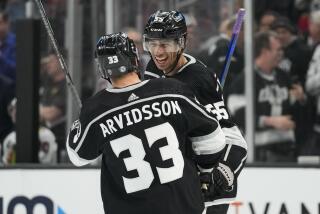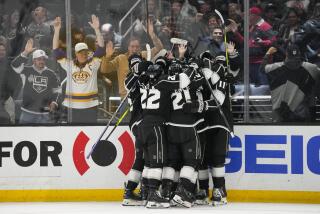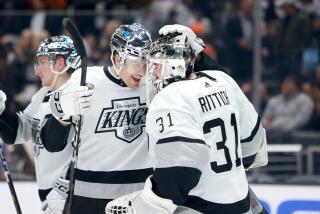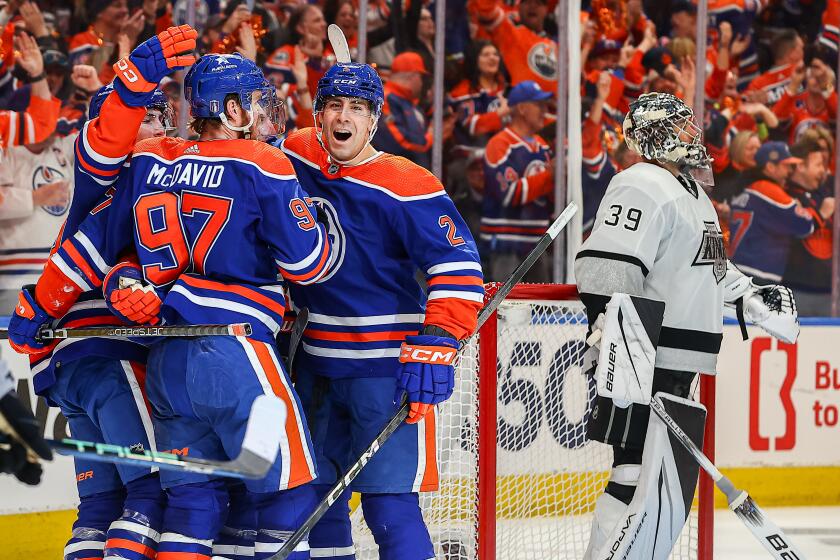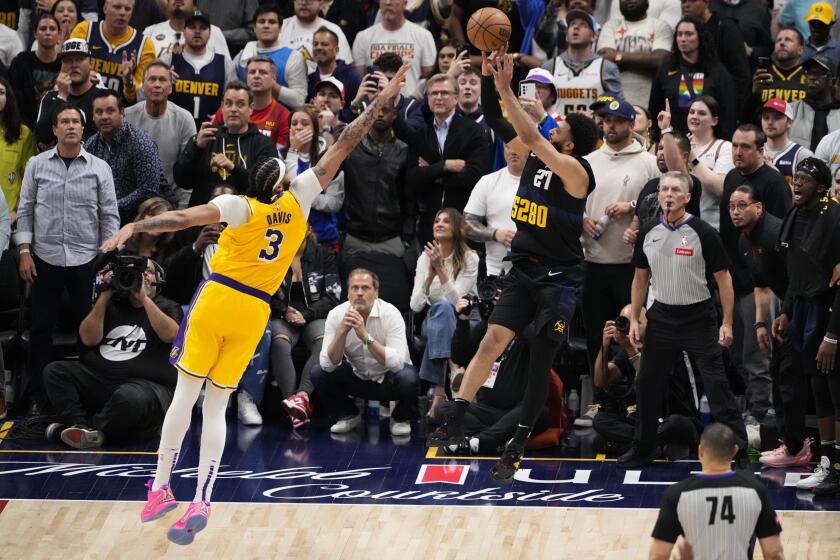Kings and Ducks are among those pleased with the NHL’s new three-on-three overtime format
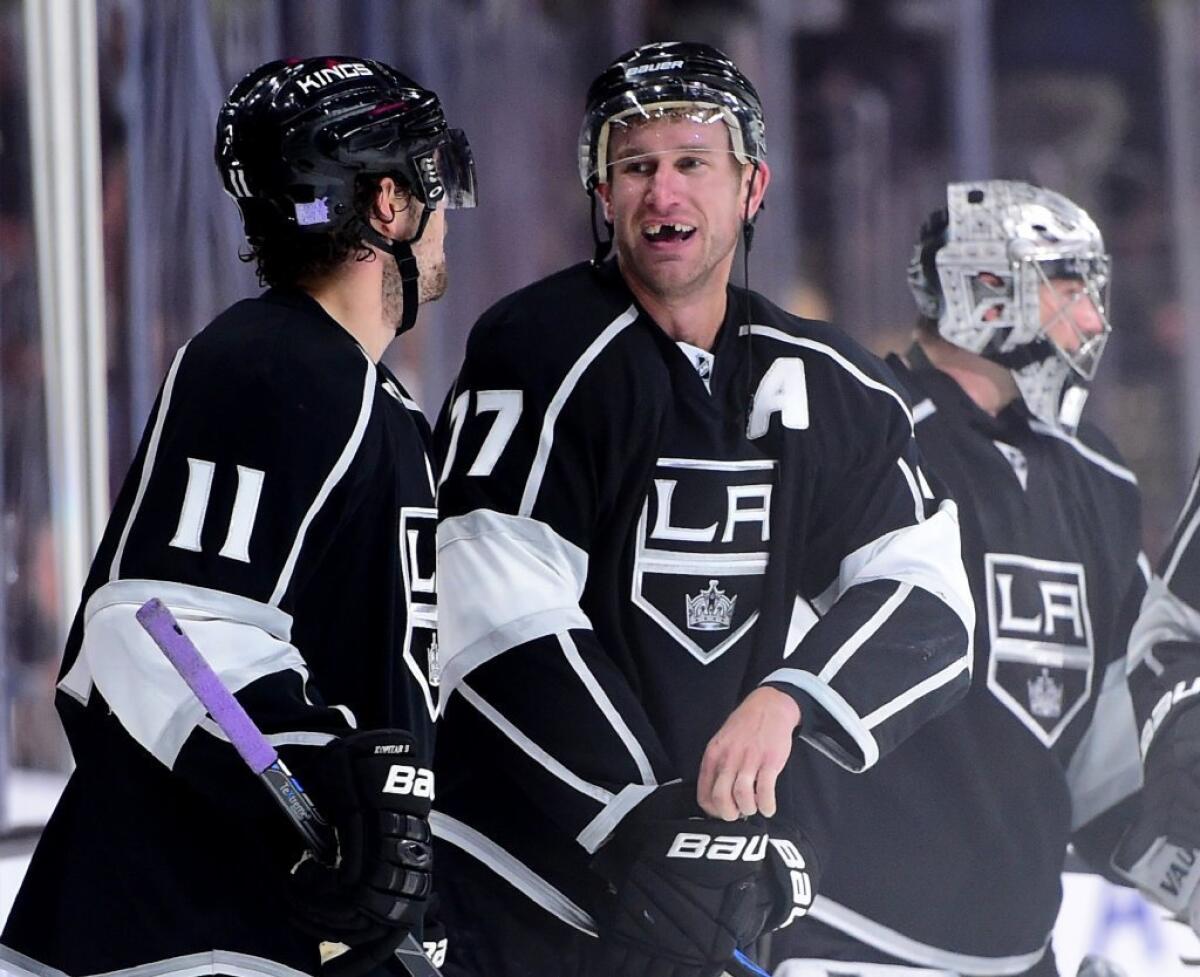
Kings forward Jeff Carter, center, reacts to his game-winning overtime goal against the Predators goal with Anze Kopitar (11) and Jonathan Quick (32) on Oct. 31.
Ken Holland, general manager of the Detroit Red Wings, said during league meetings in June that he thought a three-on-three overtime format could be more entertaining than the fan-friendly, crowd-pleasing shootout.
NHL management, coaches and players have had more than half a season to evaluate the format, which will be on display with a tournament at the All-Star event next weekend in Nashville.
You can’t quite call three-on-three overtime Mr. Holland’s opus, but the long-tenured GM in Detroit had been front and center in championing the format change.
“My personal take is that it is as good as or better than we hoped for,” Holland said in a telephone interview. “I think it’s an opportunity for our players to showcase their skills.
“We didn’t know what to expect but there’s been some highlight-reel goals, things you don’t really see in a five-on-five game.”
As you might expect, the early days of the format were like anarchy on ice. Think of kids amped up on cotton candy and ice cream and you get some idea of how it unfolded.
Then the adults took control. That would be the coaches and their defense-minded ways, looking to curb the excesses and mistakes of wide-open play with restrictive schemes.
“No matter which level of hockey you play, three on three or four on four, teams are going to find a way to be defensive in it, because you build from defense to offense,” said Ottawa forward Bobby Ryan, a former Duck.
“But it’s funny to see teams almost go into a triangle in the defensive zone and let you have the outside. It has changed in that sense. But you’re going to see three on twos and two on ones and the rushes, but teams are trying to find ways to cut down on it.”
A mistake isn’t always costly. Jeff Carter’s experience paid off when the Kings beat Nashville on Oct. 31 with his breakaway goal in overtime. That had followed a superb shutdown play by defenseman Drew Doughty, who stopped an outnumbered attack after a Carter miscue.
“It’s more just reading what’s going on,” Carter said. “There’s times where there is a turnover and you take off. You look back at the Nashville game, I turned the puck over and they’re going down three on one. At that point, there’s no chance of me getting back in the play.
“It’s probably not what the coaches want to hear, waiting to see what would happen.”
Holland and his counterparts wanted to have more games decided before the shootout. The three-on-three format has accomplished that goal.
Through Friday, 166 games had gone to overtime and 107 (64.5%) were decided in overtime).
Last season, 55.6% of the games going to four-on-four overtime needed a shootout.
The Kings were 2-8 in shootouts last season, a league low for victories, and their inability to even moderately manage the shootout cost them a playoff spot.
“Once the league put the shootout in, four on four became . . . a tie,” Kings Coach Darryl Sutter said. “Players started playing almost like they were killing a penalty.”
This season, the Kings are 6-1 in overtime games and 2-2 in shootouts. Calgary and Chicago have the most overtime victories (eight) and the Ducks and the Toronto Maple Leafs are the only teams without an overtime victory.
Only one of the five overtime losses for the Ducks went beyond the 1-minute 53-second mark.
“The last two games we’ve gone to shootouts, we haven’t allowed a goal, so that’s positive,” Ducks Coach Bruce Boudreau said. “I don’t know if we’ve figured it out. We all watch it. The players seem to know what you can and can’t do.
“We can continue to preach what you shouldn’t be doing — dumping pucks in and realize how important changes are and control of the puck is. Those are the big things.”
Ducks defenseman Cam Fowler was initially excited about the format change, a fluid skater welcoming the canvas of open ice.
“I haven’t performed as well as I’d like to in the three on three,” Fowler said, “but it’s going to be a learning process too. I think I’ve been able to see our games and watch other games and see how other guys play it.
“I think I have a little better feel of picking my spots now and making the necessary adjustments when I need to.”
The poster child for three on three has been Calgary Flames forward Johnny Gaudreau. Of his team-leading 20 goals, three have come in overtime. He has had seven overtime points in Calgary’s eight overtime victories.
His initial reaction to the format change?
“Excited,” Gaudreau said.
That’s because Gaudreau’s love of three on three dates to his childhood days in New Jersey.
“My dad got me into it in the summertimes,” Gaudreau said. “He started running three-on-three leagues at his rink. I played in two or three of them. I loved it from the start.
“I couldn’t wait until the summertime so I could play three on three again. Now I’m fortunate enough to have it here.”
Sutter and his brothers were three-on-three practitioners as children.
“There was the seven of us,” he said. “One guy was in goal and we put a bench in the other net. It was always three on three. We did it all day. We never played as a team, as five guys, until you went to town.”
Sutter believes the league should continue down its path of innovation.
“I still think there are other ways to even do a better job of it,” he said. “You won’t eliminate the shootout. But I think when there’s penalties, it shouldn’t be four on three.
“You should shorten it up again: make it three on two. If you want to take guys off, just keep doing it.”
Correspondent Curtis Zupke contributed to this report.
More to Read
Get our high school sports newsletter
Prep Rally is devoted to the SoCal high school sports experience, bringing you scores, stories and a behind-the-scenes look at what makes prep sports so popular.
You may occasionally receive promotional content from the Los Angeles Times.
